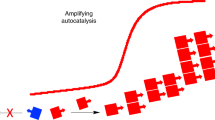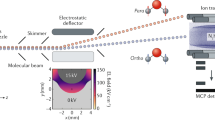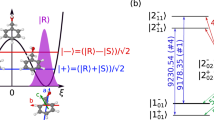Abstract
The possibility of a connection between the parity non-conserving weak interactions and the handedness of biomolecules has received recent attention1. Although the asymmetric effects of the weak interactions in molecules have been estimated to be very small2–9, Kondepudi and Nelson (KN)10–13 have shown that autocatalytic chemical systems that spontaneously break chiral symmetry14–19 can effectively amplify systematic chiral perturbations as small as those produced by weak neutral currents2–4,20, despite the simultaneous presence of larger randomly fluctuating chiral perturbations, and hence provide a mechanism for producing the observed homochirality of biomolecules. I show here, in the light of new estimates of the asymmetric decomposition of racemic mixtures by β radiation9, that the chiral selection parameter due to β radiolysis can be up to six orders of magnitude larger than that resulting from weak neutral currents. This suggests that β radiolysis is more likely to be the selector of biomolecular chirality than weak neutral currents.
This is a preview of subscription content, access via your institution
Access options
Subscribe to this journal
Receive 51 print issues and online access
$199.00 per year
only $3.90 per issue
Buy this article
- Purchase on Springer Link
- Instant access to full article PDF
Prices may be subject to local taxes which are calculated during checkout
Similar content being viewed by others
References
Mason, S. F. Nature 311, 19–23 (1984).
Rein, D. J. molec. Evol. 4, 15–22 (1974).
Hegstrom, R. A., Rein, D. W. & Sandars, P. G. H. J. chem. Phys. 73, 2329–2341 (1980).
Mason, S. F. & Tranter, G. E. Chem. Phys. Lett. 94, 34–37 (1983).
Vester, F., Ulbricht, T. L. V. & Krauss, H. Naturwissenschaften 46, 68–69 (1959).
Zel'dovich, Ya. B. & Saakyan, D. B. Soviet Phys. JETP 51, 1118–1120 (1980).
Gidley, D. W., Rich, A., Van House, J. & Zitzewitz, P. W. Nature 297, 639–643 (1982).
Hegstrom, R. A. Nature 297, 643–647 (1982).
Hegstrom, R. A., Rich, A. & Van House, J. Nature 313, 391–392 (1985).
Kondepudi, D. K. & Nelson, G. W. Phys. Rev. Lett. 50, 1023–1026 (1983).
Kondepudi, D. K. & Nelson, G. W. Physica 125 A, 465–496 (1984).
Kondepudi, D. K. & Nelson, G. W. Phys. Lett. 106 A, 203–206 (1984).
Kondepudi, D. K. & Nelson, G. W. Nature 314, 438–441 (1985).
Frank, F. C. Biochim. biophys. Acta 11, 459–463 (1953).
Decker, P. J. molec. Evol. 2, 137–143 (1973).
Hochstim, A. R. Origins Life 6, 317–366 (1975).
Fajszi, Cs. & Czege, J. Origins Life 11, 143–162 (1981).
Morozov, L. L., Kuz'min, V. V. & Goldanskii, V. I. Origins Life 13, 119–138 (1983).
Tennakone, K. Chem. phys. Lett. 105, 444–446 (1984).
Weinberg, S. Phys. Rev. Lett. 19, 1264–1266 (1967).
Author information
Authors and Affiliations
Rights and permissions
About this article
Cite this article
Hegstrom, R. Weak neutral current and β radiolysis effects on the origin of biomolecular chirality. Nature 315, 749–750 (1985). https://doi.org/10.1038/315749a0
Received:
Accepted:
Published:
Issue Date:
DOI: https://doi.org/10.1038/315749a0
This article is cited by
-
The weak nuclear force, the chirality of atoms, and the origin of optically active molecules
Foundations of Chemistry (2009)
-
Parity Violation Energy Of Biomolecules – I: Polypeptides
Origins of Life and Evolution of Biospheres (2005)
-
Effect of a chiral impulse on the weak interaction induced handedness in a prebiotic medium
Origins of Life and Evolution of the Biosphere (1995)
-
The origin and amplification of biomolecular chirality
Origins of life and evolution of the biosphere (1991)
-
Factors determining the direction of the stereoselection process in the generalized Frank model
Journal of Mathematical Chemistry (1989)
Comments
By submitting a comment you agree to abide by our Terms and Community Guidelines. If you find something abusive or that does not comply with our terms or guidelines please flag it as inappropriate.



